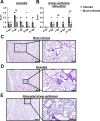A chronic Acinetobacter baumannii pneumonia model to study long-term virulence factors, antibiotic treatments, and polymicrobial infections
- PMID: 40817088
- PMCID: PMC12356904
- DOI: 10.1038/s41467-025-62655-4
A chronic Acinetobacter baumannii pneumonia model to study long-term virulence factors, antibiotic treatments, and polymicrobial infections
Abstract
Acinetobacter baumannii causes prolonged infections that disproportionately affect immunocompromised populations. Our understanding of A. baumannii respiratory pathogenesis relies on an acute murine infection model with limited clinical relevance that employs an unnaturally high number of bacteria and requires assessment of bacterial load at 24-36 h post-infection. Here, we demonstrate that low intranasal inoculums in tlr4 mutant mice allows for infections lasting at least 3 weeks. Using this "chronic infection model" we determine the adhesin InvL is a virulence factor required during later stages of infection, despite being dispensable in the early phase. We also demonstrate that the chronic model enables distinction between antibiotics that, although initially reduce bacterial burden, either lead to clearance or result in the formation of potential bacterial persisters. To illustrate how our model can be applied to study polymicrobial infections, we inoculate mice with an active A. baumannii infection with Staphylococcus aureus or Klebsiella pneumoniae. We find that S. aureus exacerbates infection, while K. pneumoniae enhances A. baumannii clearance. In all, the chronic model overcomes some limitations of the acute pulmonary model, expanding our capabilities to study A. baumannii pathogenesis and lays the groundwork for the development of similar models for other opportunistic pathogens.
© 2025. The Author(s).
Conflict of interest statement
Competing interests: The authors declare no competing interests.
Figures






Update of
-
A chronic murine model of pulmonary Acinetobacter baumannii infection enabling the investigation of late virulence factors, long-term antibiotic treatments, and polymicrobial infections.bioRxiv [Preprint]. 2024 Sep 18:2024.09.17.613469. doi: 10.1101/2024.09.17.613469. bioRxiv. 2024. Update in: Nat Commun. 2025 Aug 15;16(1):7617. doi: 10.1038/s41467-025-62655-4. PMID: 39345519 Free PMC article. Updated. Preprint.
References
-
- Cerqueira, G. M. & Peleg, A. Y. Insights into Acinetobacter baumannii pathogenicity. IUBMB Life63, 1055–1060 (2011). - PubMed
MeSH terms
Substances
Grants and funding
- R01AI166359/U.S. Department of Health & Human Services | NIH | National Institute of Allergy and Infectious Diseases (NIAID)
- 5T32HL125241-07/American Association of Immunologists (American Association of Immunologists, Inc.)
- R01 AI137062/AI/NIAID NIH HHS/United States
- R01 AI166359/AI/NIAID NIH HHS/United States
- T32AI007172/U.S. Department of Health & Human Services | NIH | National Institute of Allergy and Infectious Diseases (NIAID)
LinkOut - more resources
Full Text Sources
Medical

